Pearl No.2
The Pearl No.2 (パール2号),[1] is a folding camera taking 6×9cm pictures on 120 film, released by Konishiroku Honten in 1923 and made by its manufacturing branch Rokuoh-sha. It was the first Japanese camera sold for roll film only.
See also the Pearl (for plates and rollfilm), self-erecting 6×9 Pearl, the 4.5×6 Semi Pearl, Pearl (I), II and III and Pearl IV, and for 127 film, the Baby Pearl and Pearlette.
Contents
Description
The Pearl No.2 is a vertical folder and is not self-erecting: the front standard must be pulled out by hand after the folding bed is opened. It appeared as a rollfilm version of the Idea No.1 plate camera released the same year, whose struts, focus rails and front standard are similar. The original Pearl No.2 has a mixed construction, with a wooden main body and a metal folding bed, replaced by an all-metal construction on the improved model released in 1929.[2]
The front standard mainly consists of a U-shaped metal part, with a brilliant finder perched at the top; it has no movement ability. The bellows have single extension, and there is a distance scale on the photographer's left. The nature of the focusing control is not completely understood: some cameras have a lever in front of the lens standard certainly used for that purpose, but others have no visible control.[3]
Some examples have the name N°2 PEARL directly inscribed at the bottom of the lens standard; others have a NO 2 PEARL nameplate instead, and others have nothing at this place.[4] The name N°2 PEARL is also inscribed on a triangular nameplate riveted between the focus rails, at least on some cameras.
Evolution
Wooden model
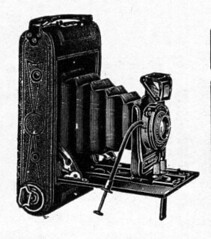
|
| Pearl No.2, wooden model. From Ars Camera June 1926. (Image rights) |
The Pearl No.2 was released in August 1923, together with the Idea No.1.[5] The original model is partly made of wood. The back is removable and is locked by a latch at the top, under the handle. It contains a single uncovered red window at the top right.[6] The spools are loaded in removable metal inserts, complete with film rollers.[7] The film is advanced by a key at the bottom right, as seen by the photographer. The brilliant finder is centered above the front standard; it is collapsible and has a square window. Decorative patterns are embossed on either side of the camera.
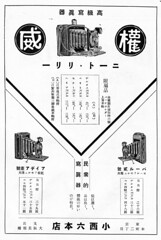
|
| Advertisement in Ars Camera November 1924. (The illustration of the Pearl No.2 is reversed.) (Image rights) |
At first the camera was supplied with a lens and shutter from Wollensak. The advertisement in Ars Camera November 1924 mentions three versions, distinguished by the lens:
The shutter is not mentioned; surviving examples are known with a Deltax No.0 (T, B, 100, 50, 25) or a Gammax No.0 (T, B, 100–10).[8]
The camera was also offered in 1924 with Testar f/6.8 or f/6.3 lenses; Tanaka suggests that this temporary measure was taken because the company was facing a shortage of lenses after its stocks were destroyed in the 1923 Great Kantō earthquake.[9] At least one surviving example is known with the Testar Anastigmat 90mm f/6.8 lens and a dial-set Pronto shutter (25, 50, 100, B, T).[10]
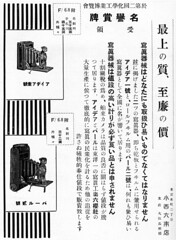 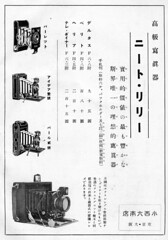 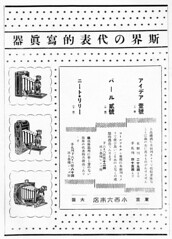
|
| Advertisements in Ars Camera June and December 1926, and February 1927. (Image rights) |
The advertisements in Ars Camera June 1926, December 1926 and February 1927 show the same illustration as in November 1924 (but oriented correctly). In June 1926, the cameras are said to have received the medal of honor (名誉賞牌) at the Second Chemical Industrial Exposition (第二回化学工業博覧会),[11] and the price of ¥32 is given for the version with f/6.8 lens, with a mention of "other models" (外種々). The December 1926 advertisement gives no specific information on the Pearl No.2, and the February 1927 advertisement again offers the camera from ¥32 upwards.
Metal models
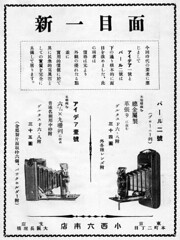
|
| Advertisement in Ars Camera May 1927. (Image rights) |
In the May 1927 advertisement in Ars Camera, important changes are announced for the Pearl No.2 and Idea No.1. The wooden body of the original Pearl No.2 is replaced by a leather-covered metal body.[12] The price is given as ¥34 with a Deltas f/6.8 lens, and the existence of other options is mentioned.
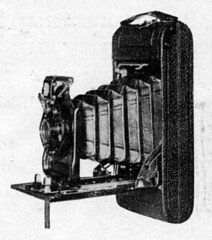
|
| Pearl No.2, early metal model. From Ars Camera May 1927. (Image rights) |
This newer metal model is easily confused with the earlier wooden model, and some sources mistakenly say that it was released in 1929.[13] The body sides are thinner, because of the new construction, and half of them comes together with the back; the handle lugs are consequently relocated. The film running direction has changed, and the advance key is now at the top right, as seen by the photographer. The red window has moved accordingly, and is now at the bottom right. It seems that the removable film inserts have disappeared: the advance key and a film flange are pulled out to insert the film spools in their respective compartments, and the film rollers are certainly attached to the body itself. The handle has been modified, and is now embossed PEARL in the middle.
The early cameras have the same brilliant finder as on the original model; surviving examples are known with the Deltas Aplanat 105/6.8 lens and a Gammax No.0 shutter (T, B, 100–10).[14] At least one example is known with the same brilliant finder offset to the left, a Trinar Anastigmat f/6.3 lens and a dial-set Pronto shutter (25, 50, 100, B, T).[15] A version with the Trinar f/6.3 and an Ibsor shutter is also reported.[16]
An improved model was released in 1930 or 1931.[17] It provides for 4.5×6 as well as 6×9 exposures, and is the earliest Japanese camera to combine these two formats; the back is modified accordingly with a row of three red windows offset to the bottom left and protected by a sliding cover — the middle one for full-frame, the other two for half-frame. The shape of the advance key has been modified too. The brilliant finder has a reduced size and a round window; it is always offset to the left, as seen by the photographer. There is an additional wire frame finder hinged on the lens assembly, with the eyepiece on the body itself.
The following lens and shutter combinations are reported for the improved model:[18]
- Deltas f/6.8 lens, Gammax No.0 shutter;[19]
- Velostigmat Ser.IV f/6.3 lens, Betax shutter;
- Trinar f/6.3 lens, Ibsor shutter;
- Trinar f/6.3 lens, Pronto shutter.[20]
Notes
- ↑ "Pearl" is written in roman script on most or all of these models. In Japanese, the line was and is called Pāru (i.e. the English word "Pearl" within Japanese phonology): the Japanese word for "pearl" is shinju (真珠), but this does not seem ever to have been applied to the camera.
- ↑ Materials: Tanaka, p.33 of Kurashikku Kamera Senka no.10.
- ↑ Lever in front of the lens standard: example pictured in this page at ksmt.com.
- ↑ Direct inscription: examples pictured in this page at ksmt.com, in this page at Neco's collection and in Lewis, p.33. Nameplate: examples pictured in Tanaka, p.33 of Kurashikku Kamera Senka no.10, and in Sugiyama, item 1111. Nothing: examples pictured in Tanaka, p.34 of Kurashikku Kamera Senka no.10, and in Sugiyama, items 1112–3.
- ↑ Chronology of the official company history Shashin to tomo ni hyaku-nen, reproduced in Tanaka, p.94 of Kurashikku Kamera Senka no.10. The date is mentioned as 1923 in Tanaka, p.33 of the same magazine, and in this page and this page at R. Konishi Rokuoh-sha.
- ↑ See the pictures in this page and this page at Neco's collection. The example pictured in this page at ksmt.com comes with a mask for 4.5×6 exposures, but this is certainly not original. Lewis, p.33, also mentions the ability to take 4.5×6cm exposures for the 1923 model, but this is surely a confusion with the later improved model.
- ↑ One insert is visible in a picture in this page at ksmt.com; the camera is certainly missing the other. The two inserts are visible inside the camera in this page at Neco's collection and in a picture in Tanaka, p.33 of Kurashikku Kamera Senka no.10.
- ↑ Deltax No.0, RR lens: example pictured in Sugiyama, item 1111, and in Tanaka, p.33 of Kurashikku Kamera Senka no.10 (this is perhaps the same). Gammax No.0, Deltas f/6.8 lens: example pictured in this page at Neco's collection.
- ↑ Tanaka, p.33 of Kurashikku Kamera Senka no.10.
- ↑ Example pictured in this page at ksmt.com.
- ↑ Advertisement in Ars Camera June 1926: 於第二回化学工業博覧会名誉賞牌受領.
- ↑ Advertisement in Ars Camera May 1927: 木製暗函を総金属製革張りに改む.
- ↑ This model is called "Pearl No.2 Improved, early version" (パール2号<改良型>前期) in Tanaka, p.33 of Kurashikku Kamera Senka no.10; however the camera pictured as such is actually a wooden model. This source and Sugiyama, item 1112, mistakenly say that the model was released in 1929.
- ↑ Example pictured in this page at Pleasure Classic Lenses, and example observed in an online auction.
- ↑ Example pictured in Sugiyama, item 1112.
- ↑ Tanaka, p.33 of Kurashikku Kamera Senka no.10.
- ↑ Year 1930: Tanaka, p.33 of Kurashikku Kamera Senka no.10, where this model is called "Pearl No.2 Improved, late version" (パール2号<改良型>後期).
Year 1931: Sugiyama, item 1113, Lewis, p.50, and this page at R. Konishi Rokuoh-sha. This other page of the same website mentions an "improved Pearl" (改良型パール) released in 1929. - ↑ Tanaka, p.33 of Kurashikku Kamera Senka no.10.
- ↑ An example is pictured in this page at Neco's collection.
- ↑ Examples are pictured in Sugiyama, item 1113, and in Tanaka, p.34 of Kurashikku Kamera Senka no.10.
Sources and further reading
- Ars Camera. Advertisement by Konishiroku Honten in November 1924, June and December 1926, February and May 1927. No page numbers.
- The Japanese Historical Camera. 日本の歴史的カメラ (Nihon no rekishiteki kamera). 2nd ed. Tokyo: JCII Camera Museum, 2004. P.11.
- Konika-Minoruta-ten (コニカミノルタ展, Konica Minolta exhibition). Exhibition catalogue. Tokyo: JCII Camera Museum, 2005. Pp.5–6.
- Lewis, Gordon, ed. The History of the Japanese Camera. Rochester, N.Y.: George Eastman House, International Museum of Photography & Film, 1991. ISBN 0-935398-17-1 (paper), 0-935398-16-3 (hard). Pp.8, 33 and 50.
- McKeown, James M. and Joan C. McKeown's Price Guide to Antique and Classic Cameras, 12th Edition, 2005-2006. USA, Centennial Photo Service, 2004. ISBN 0-931838-40-1 (hardcover). ISBN 0-931838-41-X (softcover). Pp.543–4.
- Sugiyama, Kōichi (杉山浩一); Naoi, Hiroaki (直井浩明); Bullock, John R. The Collector's Guide to Japanese Cameras. 国産カメラ図鑑 (Kokusan kamera zukan). Tokyo: Asahi Sonorama, 1985. ISBN 4-257-03187-5. Items 1111–3.
- Tanaka Masao (田中政雄). "Konica history 4. Taishō 12-nen – Shōwa 8-nen." (Konica history 4. 大正12年–昭和8年. From Taishō year 12 (1923) to Shōwa year 8 (1933).) Kamera Rebyū: Kurashikku Kamera Senka (カメラレビュー クラシックカメラ専科) / Camera Review: All about Historical Cameras no.10, September 1987. No ISBN number. Konishiroku kamera no rekishi (小西六カメラの歴史, special issue on Konishiroku). Pp.33–8.
- Tanaka Yoshirō (田中芳郎). "Meiji–Taishō jidai no Konishi Honten no kamera wo shiru tame no hon" (明治・大正時代の小西本店のカメラを知るための本, Books about the Konishi Honten cameras of the Meiji and Taishō eras). Kamera Rebyū: Kurashikku Kamera Senka (カメラレビュー クラシックカメラ専科) / Camera Review: All about Historical Cameras no.10, September 1987. No ISBN number. Konishiroku kamera no rekishi (小西六カメラの歴史, special issue on Konishiroku). Pp.92–4.
Links
In Japanese:
- Pages of the R. Konishi Rokuoh-sha website:
- Pearl cameras
- Pearl No.2 in the camera list
- Pearl No.2 and Improved Pearl No.2 in the Camera database of the Center of the History of Japanese Industrial Technology
- Pages of Neco's camera collection:
- Pearl No.2 (wooden model), with other pictures here, here and here (the camera is presented as an "early Pearl No.2 Improved" by mistake)
- Pearl No.2 (improved model), with other pictures here and here
- Pearl No.2 and Testar 90/6.8 lens specs at at ksmt.com
- Pearl No.2 with Gammax No.0 shutter and Deltas Aplanat 105/6.8 lens, in a page of cameras at Pleasure Classic Lenses by K. Yamazaki
| Konishiroku prewar and wartime cameras () | ||||||
|---|---|---|---|---|---|---|
| plate | hand cameras | stereo hand cameras | strut folders | box | telephoto | SLR |
| Idea (original) | Idea A | Idea B | Idea Snap | Idea No.1 | Idea (metal) | Lily (original) | Lily (horizontal) | Lily (metal) | Tropical Lily | Noble | Ohca | Sakura Palace | Sakura Pocket Prano | Sakura Prano | Idea Binocular | Sakura Binocular Prano | Minimum Idea | Idea Spring | Korok | Champion | Cherry | Sakura Army | Sakura Honor | Sakura Navy | Idea Telephoto | Idea Reflex (1910 and 1911) | Idea Reflex (1932) | Neat Reflex | Sakura Reflex Prano | |
| rollfilm | folders | box or collapsible | TLR | |||
| Pearlette | Special Pearlette | B Pearlette | Pearl (for plates and rollfilm) | Pearl No.2 | Pearl (Year 8) | Baby Pearl | Semi Pearl | Sakura Palace | Record | Sakura (box) | Sakura (bakelite) | Sakura-flex | ||||
